Blog

Deleveraging Not Just About Housing, More Needed To Entice Consumer Spending
Was the dramatic deleveraging ofrnAmerican households during the financial crisis solely the result of chargernoffs and defaults or were there other factors at play? The Federal Reserve of New York recentlyrnlooked at trends in consumer debt before and after the Great Recession. </p
Financial Crisis at the KitchenrnTable: Trends in Household Debt andrnCredit,rnwritten by Meta Brown, Andrew Haughwout, Donghoon Lee, and Wilbert van derrnKlaauw and published in Current Issues inrnEconomics and Finance, is based on data from the Feds Consumer Credit Panelrnwhich represents a 5 percent random sample of U.S. individuals and members ofrntheir household with credit files – in total about 15 percent of thernpopulation. The study used informationrnfrom the credit reports of these individuals for each quarter over the lastrnthirteen years, up to September 2012. </p
The Federal Reserve System’s Flow ofrnFunds Accounts show there was a steep run-up in consumer debt starting inrn1999. On March 31 of that year consumersrnowed about $4.6 trillion to creditors but over the next nine years that rosernmore than 170 percent, reaching $12.7 trillion at the end of the third quarterrnof 2008. Driving this growth was anrnincrease in residential real estate debt which almost always accounts for 70rnpercent of household liabilities. rnAmounts owned on installment mortgages and home equity lines of creditrn(HELOCs) tripled over this period, from $3.3 trillion to $10 trillion. At the same time other types of consumer debtrnnearly doubled, going from $1.4 trillion to $2.7 trillion.</p
The study found many factors accountedrnfor this increase including rising populations, rising incomes and stockrnprices, rising house prices, falling interest rates, and the “democratization”rnof credit. During this period assetsrnwere growing as well so consumers’ net wealth grew steadily over the period.</p
Delinquencies remained stable during thern1999 to 2006 period at about 4 percent of outstanding debt 30 or more days pastrndue and 2 percent over 90 days delinquent. rnThen rates rose quickly during 2007 and 2008 reaching a peak of 30+ dayrnrate of 6.7 percent at the peak of debt in Q3 2008.</p
Since then U.S. consumers have reducedrntheir debt, according to data from the Panel from an aggregate of $12.7rntrillion to $11.3 trillion or a decrease of $1.4 trillion by the end of Q3rn2012. Total debt has decreased roughlyrn11 percent from the peak with mortgage related debt now accounting for 76rnpercent; the remainder is comprised of credit cards, auto loans, student loans,rnand other consumer debt. The Flow ofrnFunds Accounts reflect a slightly lower decline in debt, slightly more thanrn$960 billion, but both sources indicate steep declines in 2009.</p
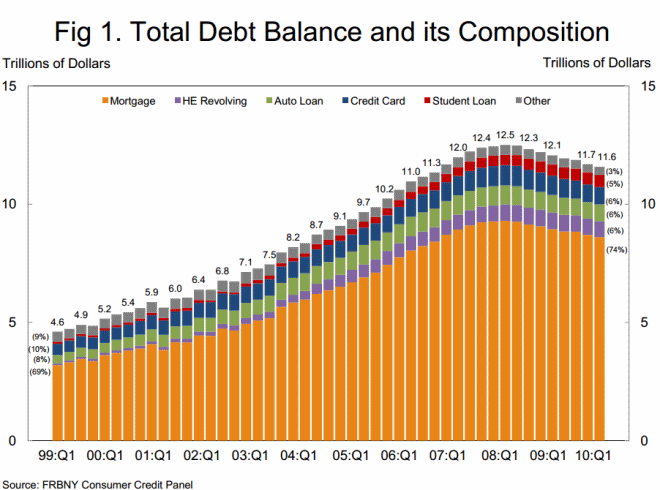 </p
</p
Even after debt peaked delinquenciesrncontinued to climb, reaching a maximum level of 11.9 percent in the fourthrnquarter of 2009 (severe delinquency peaked in Q1 2010 at 8.7 percent). Both measures of delinquency declinedrndecisively from their peaks to 8.9 percent and 6.6 percent respectively in thernthird quarter of 2012, the most recent date of available data. </p
The “flow into delinquency” measuresrndebt balances that were previously current but became delinquent in eachrnquarter. Debt performance deterioratedrnacross all debt types but it started with installment mortgage debt (excludingrnHELOCS). Between Q4 2005 and Q4 2008 newrninstallment mortgage delinquencies tripled from $98 billion to more the $310rnbillion then slowed steadily. Newrnmortgage delinquencies reached a recent low of $140 billion in Q3 2012.</p
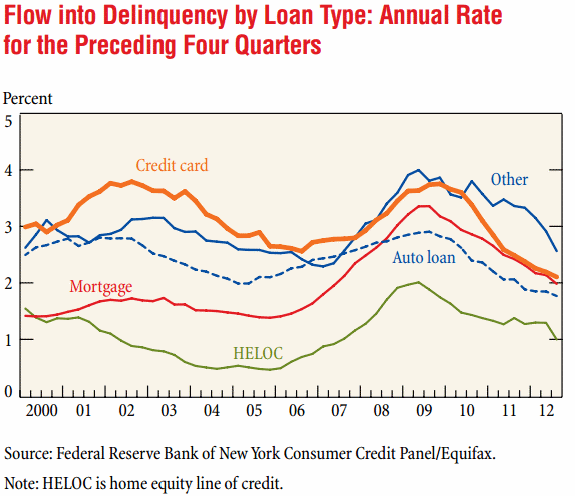 </p
</p
At least three major mechanisms accountrnfor the recent decline in consumer debt:</p
1. rnDecliningrnconsumer use of and demand for credit;</p
2. rnDecliningrnlender supply of credit;</p
3. rnAnrnincreasing amount of nonperforming debt written off by lenders.</p
If charge-offs explain the entirernreduction in debt there is little need to understand the role played by thernother two, but when charge-offs are stripped out of non-mortgage debt and thatrndebt is broken into two parts – student loans and all other loans – the studyrnfound that up to 2009 consumers were increasing both of these nonmortgage debt typesrneach year. In 2009 and 2010 the “other”rncomponent became negative ($68 billion and $15 billion respectively) butrnstudent debt continued to grow. </p
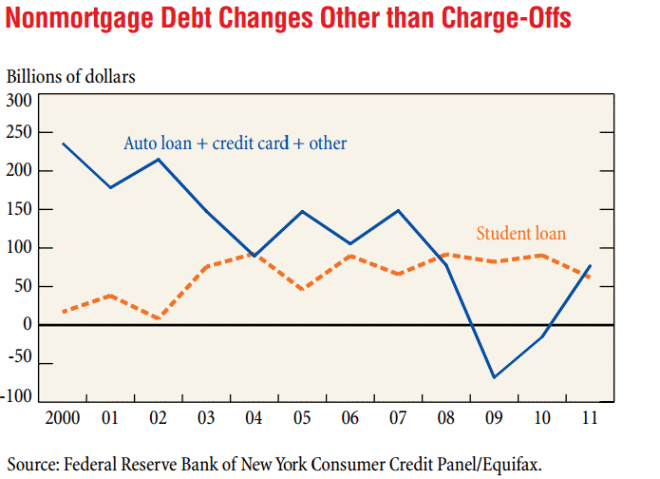 </p
</p
Accounting for mortgage debt is morerncomplicated because after a charge-off and foreclosure there is a house to be resoldrnto another party who may take on a mortgage thus reducing the net debtrnreduction from the charge-off. Thisrnprevented the study’s authors from allocating mortgage debt decline to netrncharge-offs or changes in active borrowing and repayment. Instead they focused on behavior by dividingrnthe change in mortgage balances into three components:</p
1. rnChangesrnrelated to housing transactions (payoffs, new mortgages). This component fell sharply as the value ofrnhousing transactions declined. In thisrncomponent the authors excluded the effects of charge-offs.</p
2. rnNegativerncontributions of charge-offs. Here isrnclear evidence of the foreclosure crisis with charge-offs totaling around $1.3rntrillion from 2007 through 2011.</p
3. rnCash-outrnrefinances of first liens, changes in junior-lien balances, and regularrnamortization of first lien balances.</p
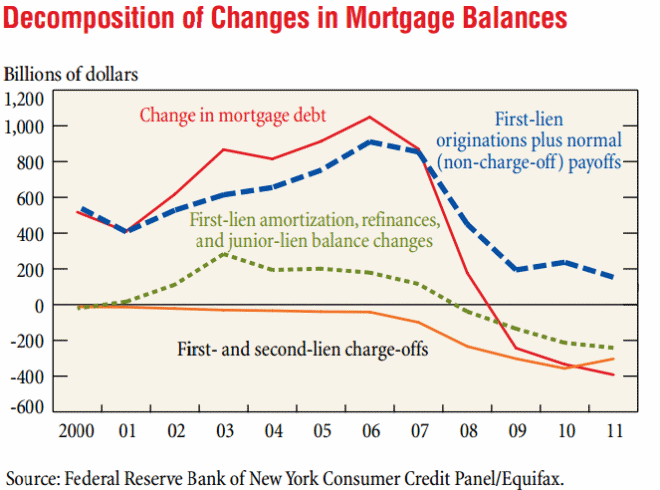 </p
</p
While amortization reduces balances at arnfairly steady pace, the other components have declined sharply since 2007. This is interpreted as indicative of consumerrnresponses to economic and financial conditions. rnFrom 2000 to 2007 they extracted equity and increased mortgage debt byrnan average of $135 billion per year; in 2008 this component turned negative andrnreached -$214 billion in 2011. </p
Taken together the information onrnmortgage and nonmortgage debt indicate major changes in consumer behavior otherrnthan delinquency and default. Borrowingrncontributed an annual average of about $350 billion to consumers’ cash flowsrnbetween 2000 and 2007, by 2010 consumers reduced their cash flows by $138rnbillion to reduce the debt, a net change of -$500 billion in just three years.</p
The remaining issue is whether this debtrnreduction was voluntary or if consumers were forced to pay down debt as creditrnstandards tightened. The study found thernfollowing:</p<ul class="unIndentedList"<liTherernwas a substantial decrease in the number of open credit accounts, especiallyrncredit cards after the 2008 peak. Creditrncard accounts dropped by 120 million between Q2 2008 and Q3 2010.</li<liThernnumber of installment and revolving credit accounts opened was high and flat during the middle of thern2000 decade but then began a decline in early 2008 that extended through Q3rn2010, falling by 40 percent to 158 million.rnSince then account openings have increased modestly to 177 million, wellrnbelow the peak.</li<liTorndetermine if the decline in new accounts was attributable to tighter lendingrnstandards or lower consumer demand the authors looked at account inquiries andrnfound significant declines, concluding that fewer applications for creditrncontributed to the decline in account openings.</li<liAccountrnclosings have rising since 1999 although not steadily. From third quarter 2008 to third quarter 2009rnthey underwent a sudden, steep increase from 226 to a peak of 376 million thenrnmoderated to 185 million. So at a timernwhen new account openings were down, accounts were being closed in recordrnnumbers, however it is unclear whether borrowers or creditors were closingrnthese accounts. There is separate informationrnthat large banks closed large number of accounts in 2009, particularly inactivernor troubled ones.</li</ul
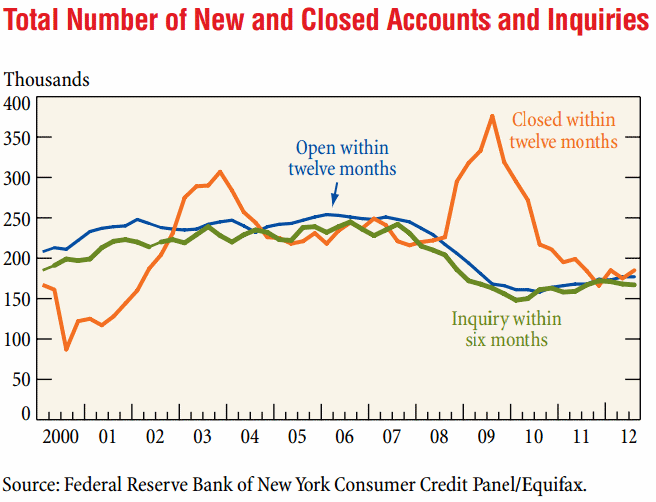 </p<ul class="unIndentedList"<liTherernwere steep decreases in borrowing limits on credit card accounts (almostrnentirely lender driven) while at the same time utilization of HELOC balancesrnincreased by 5 percentage points. </li</ul
</p<ul class="unIndentedList"<liTherernwere steep decreases in borrowing limits on credit card accounts (almostrnentirely lender driven) while at the same time utilization of HELOC balancesrnincreased by 5 percentage points. </li</ul
The authors conclude that the decline inrnconsumer debt is temporally correlated with the very rapid rise in unemploymentrnrates in the second half of 2008. rnHouseholds may choose to build their precautionary savings or increaserntheir available credit to insure cash flows against job loss. This action would tend to reduce debt balancesrnoutstanding. Households may also userncredit accounts to smooth their consumption, leading to more borrowing. While both types of behavior were present,rnthe overall decrease in debt would suggest the precautionary behaviorrndominated.</p
From the asset side of the balancernsheet, an important consequence of the initial increase and then drop in homernprices is the dramatic fall in home equity. rnGiven that the recent decline in housing prices is unprecedented inrnrecent years there is little evidence of the effect of such large declines inrnhousing wealth on the demand for debt. rnHowever, if a large decline in net worth can, in fact be expected tornincrease the marginal value of net savings, then this drop in equity may have inducedrnnet savings via reduction of mortgage debt along with other methods.</p
The question remains whether, in lightrnof recent improvements in credit availability, how much further voluntary debtrnreduction will go before consumers begin to spend again. While debt pay-down has helped improve householdrnbalance sheets it has likely also contributed to slow consumption growth sincernthe beginning of the recession. Thus therntrajectory of debt has important implications for economic growth goingrnforward.
All Content Copyright © 2003 – 2009 Brown House Media, Inc. All Rights Reserved.nReproduction in any form without permission of MortgageNewsDaily.com is prohibited.
Latest Articles
By John Gittelsohn August 24, 2020, 4:00 AM PDT Some of the largest real estate investors are walking away from Read More...
Late-Stage Delinquencies are SurgingAug 21 2020, 11:59AM Like the report from Black Knight earlier today, the second quarter National Delinquency Survey from the Read More...
Published by the Federal Reserve Bank of San FranciscoIt was recently published by the Federal Reserve Bank of San Francisco, which is about as official as you can Read More...

Comments
Leave a Comment